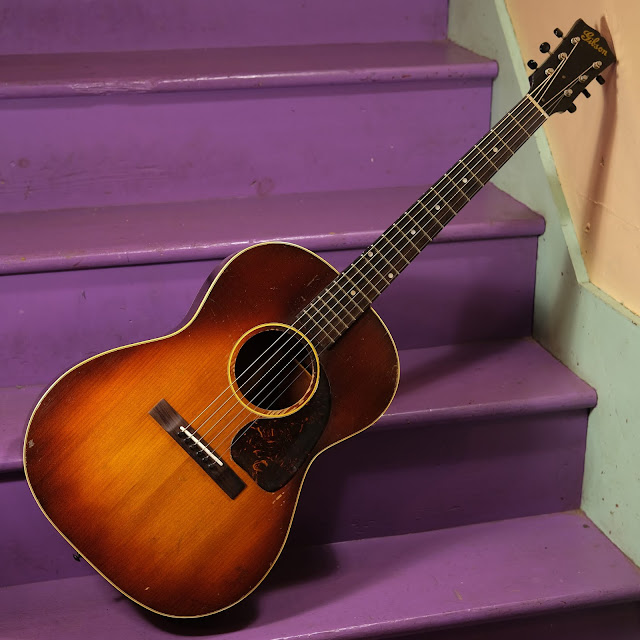1946 Gibson LG-2 Flattop Guitar
A longtime friend of the family owns this guitar and it's been neglected for quite a while. He sent it up to me in winter and I finally had time to get it in the queue -- which was fortunate, because he was passing-through on Saturday and could pick it up from me while I was doing sound at our local Harvest Fair. He'd described it as "an old Gibson student guitar." I don't know many folks who'd describe a '40s LG-2 that way these days!
This one had a rat's nest of issues to be solved and some depressing old repairs to circumvent, but the end-result is a glorious-sounding instrument. It's true that these '40s Gibsons just have that extra something about them. They're both airy and open, loud, clear, and woody all at the same time. They adore a flatpick like nothing else. I have to emphasize the volume, too -- this thing has got it in that department.
Work included: a neck reset, fret level/dress (it'd been refretted -- but the job was poor and so they were uneven), regluing many braces on the back and top and shoring-up some that'd been damaged over time, some new lining for the back and repair of the totally-open back seam, new tuner buttons for the original tuners, cutting a new bridge (the original was split) and making a new saddle, new bridge pins and endpin (ebony), general cleaning, and a setup. Action is bang-on at 3/32" EA and 1/16" DGBE at the 12th fret, the neck is straight and the truss-rod works, and strings are gauged 54w, 42w, 32w, 24w, 16, 12 -- normal "lights."
Scale length: 24 7/8"
Nut width: 1 11/16"
String spacing at nut: 1 1/2"
String spacing at bridge: 2 3/16"
Body length: 19"
Lower bout width: 14 1/4"
Waist width: 9 1/4"
Upper bout width: 11"
Side depth at endpin: 4 3/8"
Top wood: solid spruce
Back/sides wood: solid mahogany
Neck wood: mahogany
Bracing type: x-braced
Fretboard: Brazilian rosewood, synthetic nut
Bridge: Indian rosewood, bone saddle
Neck feel: medium C-shape, ~12" radius board
Condition notes: replaced bridge (not a replica, but more on that down the post), new saddle, new pins, replacement tuner buttons. The finish looks awesome for its age and has that nice, reddy-brown to medium-amber-yellow sunburst of the era. The headstock still has the script logo in good order and overall the guitar is pretty clean. There's normal weather-checking and mild-medium usewear throughout, though, with scratches mostly confined to the back and sides and some heavier pickwear around the soundhole. There's a filled/patched side jack hole on the lower-bout-side.
The original bridge was totaled but I did copy its size and wing-shape from the remains of the original. I wanted to make this a drop-in saddle (rather than a through-saddle) to make it easy to adjust action height for the owner. If someone wanted to go through-slot, it'd be easy-enough to just cut the current slot for that later-on.
What's funny is that I aligned the neck on the old pinholes during the neck reset, but when I went to start cutting the saddle and pinholes on the new bridge (I do that after it's glued), I found out that Gibson's holes weren't aligned on the center-line of the original bridge. Hah!
So -- if you look closely, you can see that the (centered) saddle has uncentered pins behind it. Oh well! That's the charm of funky old instruments. It probably would have been completely non-obvious with the original through-cut design.















Comments
When we connected at my little cousin Bens wedding and I learned of your passion and skills for building and repairing instruments, I knew that soon, I would have the love of my youth back to sing songs to my now 3 year old daughter. It’s the only voice of my father I’ve ever known and you brought that back to me. I am forever thankful and nobody will ever work on any of our stringed instruments besides you. You didn’t just repair a beautiful instrument, you’ve brought back the voice of a father to a child.
Smilingly,
Garrison